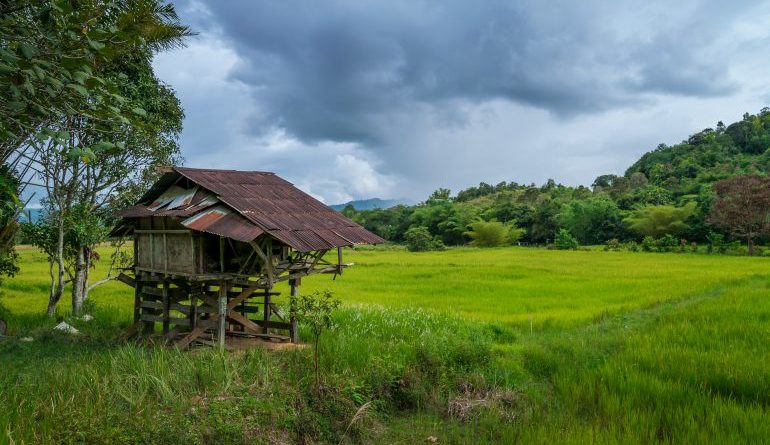LIFE+STYLE: ENVIRONMENT – Doing a good deed for the Kelabit community in Bario
Bario is famed for its picturesque view, fresh air and simplicity. Photo: Zahariz Khuzaimah
“Don’t ask how challenging Bario’s ancestral trail really is. Experience it for yourself. Only then you can share interesting stories about the hike,” jokes Bario Asal Lembaa longhouse’s headman Laju Balang@Aren Lemulun by the fireplace in the longhouse.
I was in Bario, Sarawak, together with members of the media for Volvo Trucks Malaysia’s “Seasonal Gifts” project in January 2018. This was part of Volvo Group’s CSR efforts, carried out globally to help support social concerns and communities in different countries.
Volvo Trucks Malaysia’s focus has been on Bario, the highlands situated at the northeastern tip of Sarawak, bordering Kalimantan. Bario boasts picturesque mountains, lush greenery and warm hospitality. In this remote location live the Kelabit community.
But life in this village is far from just fresh air and a bed of roses. The Kelabit rely on electricity from generators and solar panels, there is no WiFi service for mobile phones, and drinking water has to be filtered.
Temperatures can dip to 13ºC during the monsoon months. If the shower and jump pump are not functional, one has to bathe in bone-chilling water.
.

TV presenter Raelene Renai Mattu (left) and the writer attempting to start a fire to boil a kettle of water. Photo: Dishen Kumar
.

Members of the media at Volvo Trucks’ Eco-Shelter, built along Bario’s 25km ancestral trail. Photo: Ed Junaidi
.
The isolated town is an-hour’s journey by flight and a 12-hour car ride from Miri, Sarawak’s second largest city. Fuel is scarce as petrol comes all the way from Miri. There are no petrol stations to cater to villagers living in Bario.
Understanding the plight of the Kelabit community, Volvo Trucks Malaysia stepped in to lend a helping hand. It involved placing a fire-fighting system for Bario Asal Lembaa, the highlands’ oldest longhouse, and erecting five eco-shelters along Bario’s ancestral 25km jungle trail.
Volvo Trucks funded RM500,000 for both projects.
.

Ready, set, go! City journalists all prepared before venturing on their hike in Bario. Photo: Josslyn Ong
.
Arduous Trek
Bario Volvo Trucks CSR project coordinator and guide Julian Lian had suggested journalists hike up to Eco-Shelter Two, one of the five eco-shelters built by Volvo Trucks late last year. Assuring us the hike would take about five hours (three hours to ascend and two hours to descend), we eagerly took up the challenge.
At 10am the next morning, we packed a few basic necessities including sustenance, insect repellent and our cameras, slipped on our “Adidas kampung” (rubber shoes that look like football boots) and started our hike.
The ancestral trail, from Bario to Batu Lawih, was a route travelled by the Kelabit forefathers to barter trade salt, rice, preserved meat and vegetables. Cutting across deep jungles, the trail can take anything between five and six days. While the route is defunct now, it is still a popular trail among hardcore hikers.
An hour through the hike, we city-based journalists learnt the hard truth – the hike was far from a walk in the park. We had to endure leeches, unfamiliar terrain, sharp thorns, a steep climb over roots, and slippery and muddy pathways. For some writers, it was extreme challenging, both physically and mentally.
.

To survive in the jungle, you can always try consuming water from bamboo shoots. Photo: The Star/Sheela Chandran
.
Along the way, Julian – who is also Bario Asal Lembaa Long-house Safety Development Committee secretary – taught us jungle survival skills, including how to drink water from bamboo shoots and how to identify poisonous plants.
We finally reached the wooden shelter many hours later than expected. While the shelter was basic, it provided us with much needed rest, especially after trekking through thick jungle.
One can only imagine how the Kelabit ancestors travelled across the jungle, just to earn a meagre living – it must have been with great difficulty.
Volvo Malaysia managing director Mats Nilsson explained that the eco-shelters were built to make trekking more manageable. Each shelter is equipped with toilets (via a sustainable water harvesting system), providing comfort and a safe resting area for hikers.
“We hope this will help encourage tourism as more people become aware of proper resting sites with basic toilet facilities, and space for overnight rest. It also gives them the opportunity to see the wildlife from a safe perch at night. These animals usually only come out during the night to forage for food,” said Nilsson during the launch of Volvo Trucks’ “Seasonal Gifts” project in Bario. Also present at the event was Sweden ambassador to Malaysia Dag Juhlin-Dannfelt, Laju Balang and Bario village head Robertson Bala.
Paving The Way
Building the shelters came with its fair share of hurdles. Given that the trail cuts across dense forest, no vehicles could reach the shelters to drop off building material.
To ease the load, Penan men were roped in as porters to cart over 30kg of building material on their backs. The 25km project commenced in last June and was completed six months later. The distance between each shelter is five kilometres
.

(L-R) CM Global Sdn Bhd managing director Datuk Ngieng Ping Wei, Volvo Malaysia Sdn Bhd managing director Mats Nilsson, Bario Asal Lembaa longhouse chief Laju Balang and Ambassador of Sweden to Malaysia Dag Juhlin-Dannfelt at the official launch of the fire-fighting system. Photo: Volvo Trucks Malaysia
.
“In the beginning, it was a slow process as there was a lot of material to be carried into the forest. The porters and guides had to create the pathways using their machetes. I was told if the pathway were left undisturbed for a few days, the forest would ‘reclaim’ it and guides would have to start all over,” explains Nilsson.
Nilsson adds Bario was selected for the Seasonal Gifts project to enhance safety and sustainability amongst the Kelabit community.
“Over the years, 65% of the younger generation of Kelabit people have migrated out of Bario due to the lack of facilities and jobs in Bario. This has caused great concern for the community’s sustainability. We hope the added eco-shelters will help draw tourists to this beautiful place and generate a source of income for the locals.”
The fire-fighting system installed is made up of a large capacity water tank and eight hose reels for the Bario Asal Lembaa longhouse. Nilsson says it was built to counter emergency fire situations, which commonly occur in settlements like this.
“This settlement was built in 1958. It is a living historical monument by virtue of being the oldest in the area. To prevent loss of life and to preserve history, we agreed a fire-fighting system was crucial for generations to come. This is the first such system built in the Bario area.”
.
NOTE : All photographs, news, editorials, opinions, information, data, others have been taken from the Internet ..aseanews.net | [email protected] |
For comments, Email to :
Aseanews.Net | [email protected] | Contributor:









